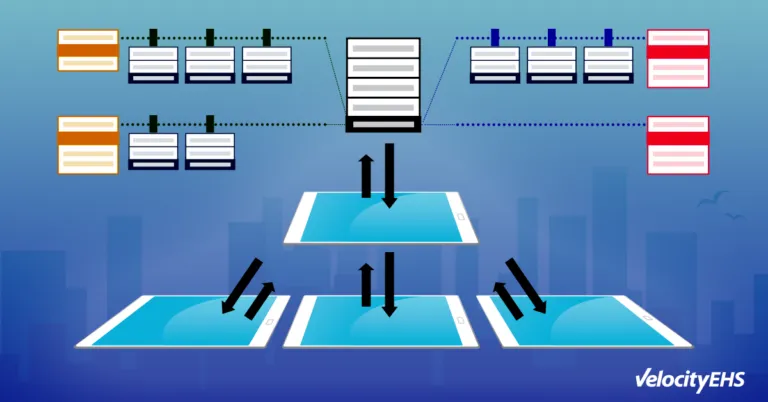Welcome to the fourth installment of our “Bowtie Analysis Blog” series. In our first installment, we talked about the usefulness of risk bowties for training employees on workplace risks, our second installment explored the way they can pull together information from many different types of assessments, and our third post discussed how bowties help visualize and manage risk controls.
Now, we’ll be looking at the ways a specific type of risk bowtie, called a master bowtie, simplifies our ability to manage risks across multiple facilities.
Challenges of Managing Risk at Multiple Facilities
In this series, we’ve examined some of the ways that traditional approaches to managing risk, like using spreadsheets and tables, make it hard to establish an accurate view of risk and share it with our workers. For example, tables encourage us to oversimplify risk pathways by viewing them too linearly, and they don’t account for multiple causes and multiple consequences of an unplanned event. It’s also hard to access the risk information when we most need it, or to use it to quickly get an overview of risks at a facility.
The reality is that many of us also have responsibility for managing safety and risk at multiple locations within our company, which compounds those challenges. These facilities might have similar operations, meaning that many risk pathways and controls will be very similar, but not exactly the same. Creating risk assessments for each individual facility is a lot of work, and there are many opportunities for errors. For example, site operators assessing risks independently of each other have no ability to build on existing knowledge, creating the potential for gaps in risk control.
We’ve seen that risk bowties make risk management easier by helping users quickly map risk pathways and develop a common understanding of risk across a facility. Can risk bowties also improve the way we manage risks across different facilities?
The answer is “yes,” and this is exactly what makes master bowties so important.
How Master Bowties Help
Master bowties are a kind of blueprint for risk pathways that can be used for development of risk bowties for individual sites. This makes them directly useful for cutting down on the work and increasing the accuracy of our mapped risk pathways. Here’s how they work.
As a risk manager, you develop your master bowtie the same way you develop any other risk bowtie. When using software like VelocityEHS Risk Management, that’s as simple as clicking a button. You then edit the master bowtie before finalizing it, and activating it. Once activated, a master bowtie is now available for generating individual site bowties.
It’s then a simple process to generate a site bowtie from the master bowtie, and select a specific site representative responsible for reviewing and managing the site bowtie. That user gets an email notification that they have a site bowtie to review, and they can access the bowtie via a link. At that point, the user begins the review process, and essentially “owns” any changes made. The figure below shows the relationship between the master bowtie and site bowtie. Note how changes in the master bowtie flow “downward” to the site bowties.

During review, the user can select which causes, controls and consequences to include or exclude in the site bowtie. To limit the possibility of mistakenly excluding master bowtie features relevant to the site bowtie, you should consider ensuring that software used for your risk bowties prompts the user to provide an explanation for the exclusion.
What if, in the process of managing risk at the company level, we learn new information about risk pathways, or decide to make changes to controls that will affect every facility that has the same operations and same risk pathways? That’s another advantage of using master bowties. When you’re using VelocityEHS Risk Management, changes you make to the master bowtie are applied to all of the site bowties based on it. It also sends notifications to the “owners” of those bowties, prompting them to review the changes. The facility user can then just accept or reject the changes as appropriate, as long as they include an explanation for any exclusions made.
There may be times when a facility’s operations change significantly enough that maintaining a connection between the site bowtie and master bowtie no longer makes sense. In that case, you can easily unlink the bowtie from the master risk scenario, creating an ad hoc bowtie. Just keep in mind that this is an irreversible process, so once the site bowtie is unlinked, there’s no going back.
We can see that this process is both much easier and more accurate than methods based on individual assessment of risk across facilities. The benefits of using master bowties include:
- Standardized identification and control of risks throughout the organization
- Improved sharing of risk information and risk management best practices
- Reduced time and resources required to develop and review risk bowties and perform other risk management activities at individual locations/work sites
- Reduced administrative costs and increased stakeholder engagement with your risk management programs
Additionally, master bowties can help users reduce the time to review from an average of 2 hours to just 10-15 minutes, and cut the duration of their annual site risk reviews by nearly 90%.
Looking for More Information?
If you’re looking for a quick way to help you learn more about risk bowties, download our risk bowties infographic. It shows how they can help you develop a comprehensive view of risks, which can easily be kept updated and used to train your workforce.
And of course, stay tuned for the fifth and final installment of our “Bowtie Analysis” blog series!
Let VelocityEHS Help!
Our customers consistently report that our bowtie analysis capabilities have helped them achieve dramatic improvements to workplace productivity, knowledge sharing and risk management program performance.
Bowtie analysis is just one of many tools within our Risk Management solution, which also includes risk registers, qualitative and quantitative risk analysis, layers of protection analysis (LOPA), critical controls verification and much more!
Ready to see more? Visit our Risk Management page to request a demo with one of our customer solutions consultants today!
